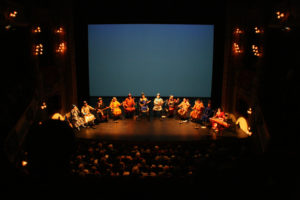The Creation and The Tour
To introduce, enhance and improve knowledge on the art of khöömii to a wider audience, following the release of An Anthology of Mongolian Khöömii in January 2017, a musical creation and a tour are planned for the period of Spring-Summer 2016.
Engaging 12 artists invited from Mongolia, this two-month tour in Europe will be a direct reflection of the spirit of the Anthology. Such a large-format tour dedicated to Mongolian khöömii is the first to be realized. Preceded by a one-week residency at La Fonderie in Le Mans, the concerts will bring together khöömii heritage bearers, female and male professionals, legendary masters and ascending young artists at the same stage, offering an exciting moment of discovery of the rich and diverse aspects of overtone singing practice of Mongolia. Through the concerts and the accompanying workshops, concert-lectures and meetings within the framework of the tour, the audience can discover and enjoy the different vocal techniques and their repertories, khöömii-nature relation, various accompanying instruments, styles and techniques of overtone singing, rural and urban sensibilities as well as innovations in its genuine forms from Mongolia.
Besides, in order to present the diversity of vocal techniques and traditional musical repertoire, as well as to launch new artistic projects, we invite exceptionally one singer of urtyn duu, the Mongolian long song.
As a major event promoting the spirit of the Convention for the Safeguarding of the Intangible Cultural Heritage of UNESCO, the aim of the disc, creation and tour is to show the Mongolian khöömii in all its contemporaneity and create a tool for its transmission. It also promotes the cultural diversity and human creativity in today’s global society by contributing the dissemination of this heritage, as it is conveyed by the Mongolian people, all over the world.
Videos
Biographies of the Musicians
Sengedorj Nanjid
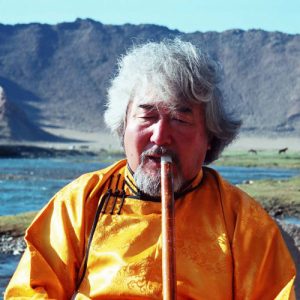 Birth
Birth
1948, district of Chandmani, province of Khovd. Ethnic group Khalkh.
Khöömii career path
Self-taught, by imitating the khöömii singers around him, especially the master Sundui. International performance since the late 1970s. Retired since 2009, he built his professional background at the Dramatic Theatre at Khovd city.
Musical practice
Three techniques of khöömii: kharkhiraa (deep khöömii), khamryn kharkhiraa (nasal deep khöömii) shingen khöömii (high khöömii) and lute tovshuur, flute tsuur.
Characteristic
The «baritone khöömii» is the name he gives to his own style. He teaches khöömii to a limited number of students at home.
Discography
- Anthology of Mongolian khöömii, 2016 (Routes Nomades & Buda Musique)
- Dörvön Berkh, Four Shagai Bones, Masters of Mongolian Overtone Singing (PAN 2100, 2010, Pan Records)
- Mongolie, Chants et Morin Khuur (C 560224, Ocora Radio France, 2009)
- Where Rivers and Mountain Sing. Sound, Music, and Nomadism in Tuva and Beyond, (2006, Bloomington, Indiana University Press)
- Tungalag Buyant (MOCN-0202, 2002, Japon)
- Mongol Nutgiin Calxi (MOCN-0102, 2001, Japon)
- The spirit of the steppes: Throat-singing from Tuva and beyond (Nascente NSCD 058, 2000, Londres)
- Jargalant Altai. Xoomii and other vocal and instrumental music from Mongolia (Pan 2050CD, 1996, Pan Records)
- Mongolie: Musique et chants de l’Altai (Orstom-Selaf Ceto 811, 1986, Paris)
References
Théâtre de la Ville, Scène nationale d’Orléans, Musée du quai Branly, Amphi-Opéra Opéra of Lyon, Opéra of Lille, Festival Les Orientales, Festival Le Rêve de l’Aborigène, Week of Mongolia in Flanders, Musée des Arts Asiatiques of Nice…
Odsüren Baatar
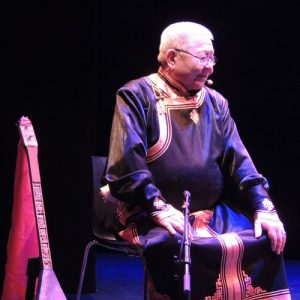 Birth
Birth
1949, district of Aldarkhaan, province of Zavkhan. Ethnic group Khalkh.
Khöömii career path
Learnt khöömii from S. Myagmar, after having learnt the magtaal praise song. Besides his principal activity of teaching overtone singing, he participates in many international tours.
Musical practice
Twelve techniques of khöömii, some of which are his innovations: khargia khöömii (deep khöömii), gilsen khöömii, tsuurai khöömii (echo khöömii), üyelzsen tsuurai khöömii (whirling echo khöömii), shuluun tsuurai khöömii (straight echo khöömii), khamryn tsuurai khöömii (nasal straight khöömii), dorgio khöömii (jolted khöömii), kherkheree khöömii (gargle khöömii), isgeree khöömii (whistle khöömii), dangildakh khöömii (monosyllabic rhythmic khöömii), doshgiraa khöömii (labial vibration khöömii) khosmoljin khöömii (combined khöömii) and fiddle ekel, lute tovshuur, mouth harp khulsan khuur (in bamboo) and tömör khuur (in metal).
Characteristic
First to teach khöömii at the establishments of higher education system (National University of Mongolia, University of Culture and Arts) in Mongolia. Regularly transmits khöömii in Buryatia (Russia), Inner Mongolia (China) and Europe during the concert tours. One of the first khöömii singers to teach overtone singing to women.
Discography
- Anthology of Mongolian khöömii, 2016 (Routes Nomades & Buda Musique)
- Dörvön Berkh, Four Shagai Bones, Masters of Mongolian Overtone Singing (PAN 2100, 2010, Pan Records)
References
Festival d’Automne, Musée du quai Branly, Amphi-Opéra Opéra of Lyon, Opéra of Lille, Festival Les Orientales, Festival Le Rêve de l’Aborigène, Week of Mongolia in Flanders, Musée des Arts Asiatiques of Nice…
Tserendavaa Dashdorj
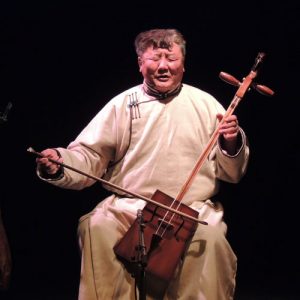 Birth
Birth
1954, district of Chandmani, Khovd province. Ethnic group Khalkh.
Khöömii career path
Apprenticeship in the pastoral way of life by imitation of his masters and models. Worldwide performance since 1980s.
Musical practice
Seven techniques of khöömii: uruulyn khöömii (labial khöömii), tagnain khöömii (palatal khöömii), bagalzuuryn khöömii (throat khöömii), khamryn khöömii (nasal khöömii), tseejnii khöndiin khöömii (chest khöömii), khargia khöömii (deep khöömii), khosmoljin khöömii (combined khöömii) and lute tovshuur, horse-head fiddle morin khuur and fiddle ekel.
Characteristic
Innovator of the khosmoljin technique in the khöömii tradition. Member of the “Jargalantyn tsuurai” group (with Davaajav), one of the first khöömii ensembles in Mongolia. One of the rare khöömii singers to keep the nomadic lifestyle besides the overtone singing career. Transmits khöömii tradition to his children, nomads of his region, as well as numerous foreigners on the spot and during his concert tours. One of the first khöömii singers to start teaching the overtone singing to women.
Discography
- Anthology of Mongolian khöömii, 2016 (Routes Nomades & Buda Musique)
- Dörvön Berkh, Four Shagai Bones, Masters of Mongolian Overtone Singing (PAN 2100, 2010, Pan Records
- Tserendavaa & Tsogtgerel, Chants diphoniques de l’Altaï mongol, (Buda Musique, 2008, Paris)
- Mongolian Music, Dance, and Oral Narrative (C. Pegg, University of Washington Press, 2001)
- Chandman’Song, Traditional Mongolian melodies sung in Khoomii (overtone singing), (Amina Records TS001, 2001, Mongolie)
- Mongolia, Living music of the steppes, instrumental music and song from Mongolia (Multicultural Media MCM 3001, JVC 1997, Japon)
- Jargalant Altai. Xoomii and other vocal and instrumental music from Mongolia (Pan 2050CD, 1996, Pan Records)
- Mongol Music, Various artists (Cassette de la Radio Nationale Mongole)
- Music and song of Mongolia Live at Cambridge, Various artists (Cassette Global Arts GA1, 1988, UK)
- Music from Mongolia, Live at the Asia Society, Various artists (Cassette, 1987, USA)
- Musique et chants de tradition populaire Mongolie, Various artists (Grem G7511, 1985)
References
Musée du quai Branly, Amphi-Opéra Opéra de Lyon, Opéra of Lille, Festival Les Orientales, Festival Les Escales, Festival Le Rêve de l’Aborigène, Festival Les Nuits de la Voix, Week of Mongolia in Flanders, Musée des Arts Asiatiques of Nice…
Ganzorig Nergüi
 Birth
Birth
1974, district of Zuunkharaa, province of Selenge. Ethnic group Khalkh.
Khöömii career path
Self-taught, from the age of 15 by listening to the radio and the recordings of some masters of khöömii, such as Sundui and Ganbold. Charter member of the Altai-Khangai group.
Musical practice
Several techniques of khöömii: uruulyn khöömii (labial khöömii), bagalzuuryn khöömii (throat khöömii), khamryn khöömii (nasal khöömii) and kharkhiraa (deep khöömii) and lute tovshuur, horse-head fiddle morin khuur, flute tsuur and mouth harp khulsan khuur (in bamboo) and tömör khuur (in metal). Professional musician.
Characteristic
Compositions of praise songs magtaal, with many innovations brought to the overtone technique.
Discography
- Anthology of Mongolian khöömii, 2016 (Routes Nomades & Buda Musique)
- Ongod (Full Rhizome – Buda Musique, 2013)
- Dörvön Berkh, Four Shagai Bones, Masters of Mongolian Overtone Singing (PAN 2100, 2010, Pan Records)
- Mongolie, Chants et Morin Khuur (C 560224, Ocora Radio France, 2009)
- Naadam, (autoproduction, 2006, Oulan-Bator)
- Melodious Tree, (AKA09001, autoproduction, 2000, France)
- Gone with the Wind. Songs of mongolian steppes, Window to Europe (WTE CD002, 1998, Hollande)
- Naariits Bülye Let’s Dance. Mongolian khuuryn tatlaga, (Pan 2061, 1997, Pan Records)
References
Carnegie Hall, World Sacred Music Festival of Fès, Festival Détours de Babel, Festival Mawazine, Divan du Monde, Planètes Musiques, Ateliers d’Ethnomusicologie, Musée du quai Branly, Amphi-Opéra Opéra of Lyon, Opéra of Lille, Festival No Border…
Amartüvshin Baasandorj
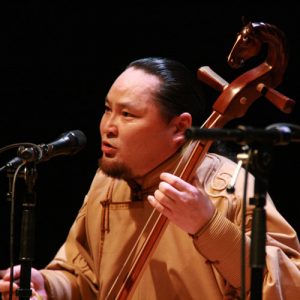 Birth
Birth
1976, district of Chandmani, province of Khovd. Ethnic group Khalkh.
Khöömii career path
Learnt khöömii with his father Baasandorj, his elder brother Tumur and his uncles Ganbold & Gereltsogt. Professional khöömii singer of Egschiglen group in Germany.
Musical practice
Five techniques of khöömii: kharkhiraa (deep khöömii), shakhaa khöömii (pressed khöömii), nariin khöömii (high khöömii), khamryn khöömii (nasal khöömii), khosmoljin khöömii (combined khöömii), lute tovshuur, horse head fiddle morin khuur.
Characteristic
Détenteur du khöömii de la lignée directe du maître Ganbold et de son frère Gereltsogt, il est reconnu par la finesse et l’élégance de son khöömii.
Discography
- Anthology of Mongolian khöömii, 2016 (Routes Nomades & Buda Musique)
- Kyriakos Kalaitzidis et En Chordais, The Musical Voyages of Marco Polo (World Village, Harmonia Mundi, 2014)
- Bishirtugei, ayuutugai (autoproduction, 2009, Oulan-Bator)
- Egschiglen, Gereg (HE 17, 2007, Heaven and Hearth)
- La route musicale de la Soie, The Musical Silk Road (AC10, 2004, Accords Croisés)
- Egschiglen, Zazal (HE10, 2004, Heaven and Hearth)
- Egschiglen, Sounds of Mongolia (EUCD 1652, 2001, Arc Music)
References
Festival Musiqat, Mediterranuoro e dintorni Festival, Prix Creole Bavaria, Universal Forum of Cultures Barcelona, Festival Millau, Full Colour Festival, WOMEX Essen, Olympiahalle München, WOMAD Festival Reading, IOV Festival Carrara…
Davaajav Rentsen
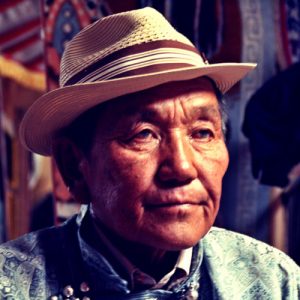 Birth
Birth
1952, district of Chandmani, province of Khovd.
Khöömii career path
Initiated to khöömii by his brother Namjil and the grand master Sundui. International performance especially during the soviet era. Transmits khöömii to his two sons, to local people and some foreign students.
Musical practice
Several techniques of khöömii: tseejnii khöndiin khöömii (chest khöömii), nariin khöömii (high khöömii), khargia khöömii (deep khöömii), khamryn khöömii (nasal khöömii) and lute tovshuur.
Characteristic
Member of the group “Jargalantyn tsuurai” (with Tserendavaa), one of the first khöömii ensembles in Mongolia. Herder, one of the rare khöömii singers to conserve the pastoral lifestyle and the professional practice of overtone singing.
Discography
- Anthology of Mongolian khöömii, 2016 (Routes Nomades & Buda Musique)
- Jargalant Altai. Xöömii and other vocal and instrumental music from Mongolia (PAN 2050CD 1996, Pan records).
References
Several editions of the National Festival of Traditional Arts of Mongolia as well as national and international competitions of overtone singing.
Papizan Badar
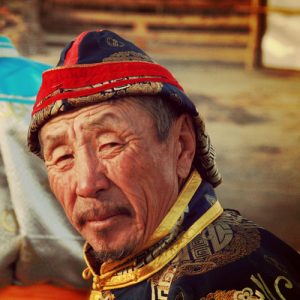 Birth
Birth
1957, district of Tsengel, province of Bayan-Ulgii. Ethnic group Tuva.
Khöömii career path
Self-taught, inspired by Baldan, a respected man in his community.
Musical practice
Several techniques of Tuvinian khöömii: uulyn kharkhiraa (deep khöömii of mountain), khöömii, isgeree (whistle khöömii), ayany khöömii (travel khöömii), golyn khöömii (river khöömii) and flute tsuur, lute tovshuur, fiddle ekel. Instrument maker.
Characteristic
Reprentative of the Tuvanian overtone singing in Mongolia, he teaches khöömii and traditional instruments to the children of the secondary school and adults of his village.
Discographie
- Anthology of Mongolian khöömii, 2016 (Routes Nomades & Buda Musique)
- Uuls tuulisyn oron, 2014
References
Several editions of the National Festival of Traditional Arts of Mongolia as well as regional and national competitions of overtone singing.
Batsükh Dorj
 Birth
Birth
1990, district of Tsengel, province of Bayan-Ulgii. Ethnic group Tuva.
Khöömii career path
Initiated by Papizan, learnt khöömii with his brother Butemj, then developed himself by listening to the recordings. Graduated from the Music College of the Tuva Republic.
Musical practice
Several techniques of khöömii, in Mongolian and Tuvanian styles: khöömii, isgeree (whistle khöömii), kharkhiraa (deep khöömii), ezengileer, borbagnadyr and fiddle ekel, lute tovshuur.
Characteristic
Taught music at the secondary school of his village until 2014. Currently works in the mining. Instrument maker.
Discography
- Anthology of Mongolian khöömii, 2016 (Routes Nomades & Buda Musique)
References
Number of festival and competitions of traditional arts, regional and national competitions of overtone singing.
Toivgoo Ejee
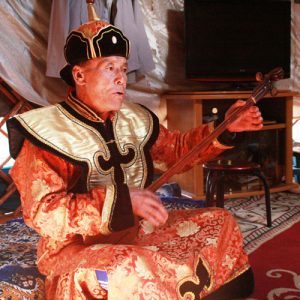 Birth
Birth
1957, district of Zuungovi, province of Uvs. Ethnic group Bayad.
Khöömii career path
Self-taught, worked as a soloist khöömii singer at the Dramatic Theatre of Uvs for 30 years. Professional musician who transmits overtone singing. Charter member of the Altai Khairkhan group.
Musical practice
Several techniques of khöömii: kharkhiraa (deep khöömii), zadgai kharkhiraa (open deep khöömii), bituu kharkhiraa (closed deep khöömii), isgeree khöömii (whistle khöömii) and lute tovshuur.
Characteristic
Known as “The king of the breath” in Mongolia, he is the khöömii singer who has the longest respiration. One of the first to teach khöömii to women.
Discography
- Anthology of Mongolian khöömii, 2016 (Routes Nomades & Buda Musique)
- Whistle in the Wind, Mongolian Overtone Singing, Altai Khairkhan ensemble, (Window to Europe/Noord Azië Instituut Tengri, 2003)
References
Several editions of the National Festival of Traditional Arts of Mongolia as well as national and international competitions of overtone singing. International tours.
Ösökhjargal Pürevsüren
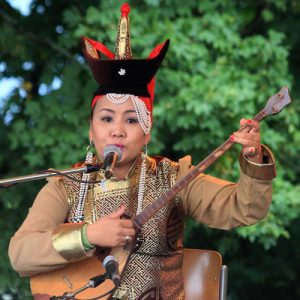 Birth
Birth
1973, Ulaanbaatar, capital of Mongolia. Ethnic group Khalkh.
Khöömii career path
Apprenticeship with Odsuren (his second female student). Since 2001, she performs around the world with the Khukh Mongol group.
Musical practice
Several techniques of khöömii: isgeree khöömii (whistle khöömii), kharkhiraa khöömii (deep khöömii), isgereetei kharkhiraa (whistle khöömii with deep khöömii), khamryn khöömii (nasal khöömii) and lute tovshuur.
Characteristic
The only Mongolian woman who represents khöömii in Europe, she founded “Khatan” a group of female musicians. Professional musician residing in Germany.
Discography
- Anthology of Mongolian khöömii, 2016 (Routes Nomades & Buda Musique)
- Best of Khukh Mongol Folk Art Ensemble (autoproduction)
- Khukh Mongol, Minii nutag (LC 12455, 2004, 5Special)
- Khukh Mongol, Chinggis Khaan (autoproduction, 2002, Allemagne)
References
International tours.
Khulan Navaandemberel
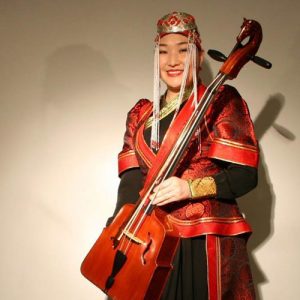 Birth
Birth
1989, district of Yeruu, province of Selenge. Ethnic group Khalkh.
Khöömii career path
Graduated from the University of Culture and Arts as musician and music teacher. Plays for the groups Khukh Mongol and Khatan, she also worked for the group Hosoo & Transmongolia.
Musical practice
Born in a family of traditional musicians, she learnt playing the cithara yatga and fiddle morin khuur from the age of 13.
Characteristic
Plays the morin khuur fiddle in traditional way and in style of current standardized school. Her morin khuur repertory is consisted of over 50 pieces.
Discography
- Anthology of Mongolian khöömii, 2016 (Routes Nomades & Buda Musique)
References
Number of international festivals and stages in South Korea, China, Germany, Switzerland, Belgium, Netherlands, Czech Republic, Austria, Sweden, France and Italy.
Erdenetsetseg Khenmedekh
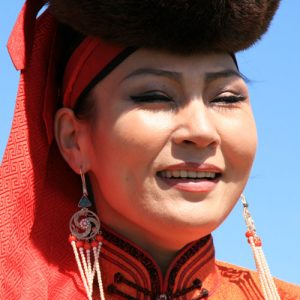 Birth
Birth
1972, district of Mandalgovi, province of Dundgovi. Ethnic group Khalkh.
Khöömii career path
Grew up in singers’ family, she’s been in the tradition of long song since her childhood. Started learning long song formally with Chuluuntsetseg at the University of Culture and Arts in Ulaanbaatar since 2000. Singer at the National Academic Ensemble of Music and Dance of Mongolia and Altan Urag group, the pioneer of ethno-rock in Mongolia.
Musical practice
Urtyn duu (long song), bogino duu (short song). Her long song repertory is consisted of more than 30 pieces.
Characteristic
Third-generation long song singer, besides her career, she conducts researches on the rare and ancient aspects of long song for restoration and transmission of songs.
Discography
- Anthology of Mongolian khöömii, 2016 (Routes Nomades & Buda Musique)
- Shanztai duunuud (autoproduction, 2015, Oulan-Bator)
- Once upon a time in Mongolia (autoproduction, 2010, Oulan-Bator)
- Mongol, BO du film du même nom, (autoproduction, 2010, Oulan-Bator)
- Nation, (autoproduction, 2010, Oulan-Bator)
- Blood (autoproduction, 2009, Oulan-Bator)
- Hypnotism (autoproduction, 2008, Oulan-Bator)
- Made in Altan Urag, (autoproduction, 2006, Oulan-Bator)
- Unaga töröv, A foal’s been born, (autoproduction, 2004, Oulan-Bator)
References
International tours, Bolshoi theater, UNESCO headquarter, Fuji Rock Festival, Plenitude World Music Festival, several soundtracks (Khadak, Mongol, and Marco Polo).

